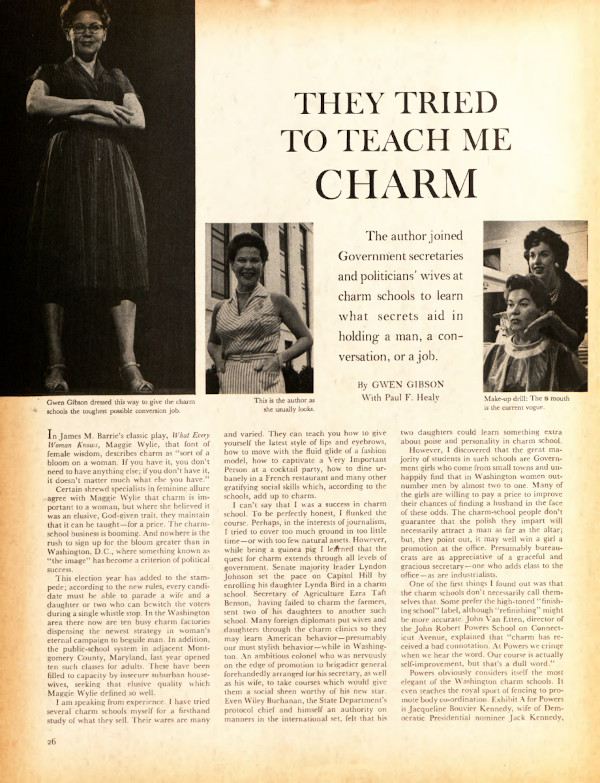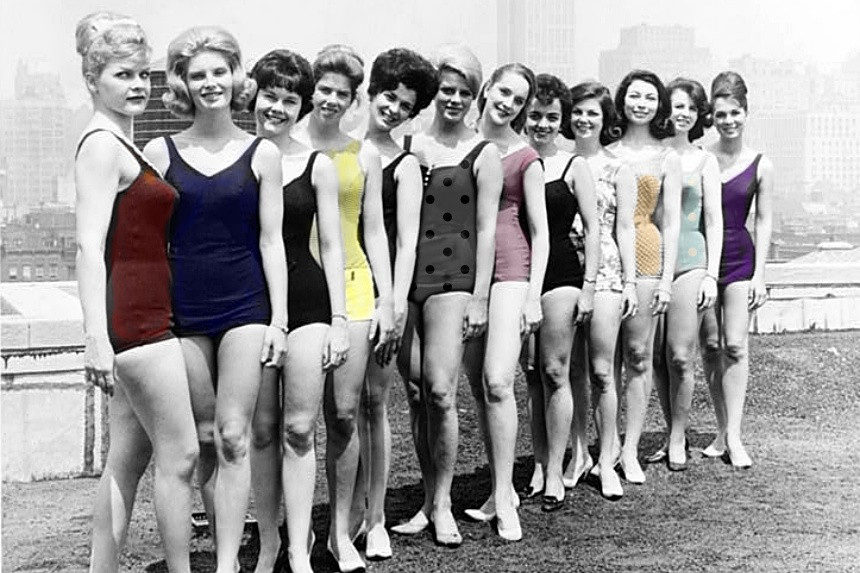It’s unlikely that when future generations look back on this era, the word “charm” will pop into their heads.
In a time of trolling, bullying, flame wars, hate speech, and armed protests, such a concept seems quaint and useless. But charm is still with us, and organizations from The Etiquette School of New York to MIT are now offering instruction in attaining it.
At its least, charm is the ability to put people at their ease. In larger amounts, it delights people and arouses their admiration.
It is the culmination of good manners, but it is never an obvious display of etiquette. Said actress Sarah Bernhardt charm is “made of everything and nothing.” Charm usually catches people unaware; they find themselves captivated by and agreeing with the charmer. As Albert Camus described it, charm is “a way of getting the answer yes without having asked any clear question.”
Today’s charm instructors show the proper conversation, table manners, posture, and wardrobe to make the best impression. And there’s a growing market for it. Until the pandemic, Myka Meier had been teaching social, business, and dining etiquette at New York’s Plaza Hotel. She was mentored by a former member of the Royal Household in Britain and received further training at Switzerland’s last remaining finishing school. Earlier this year, she was addressing sold-out classes and her book, Modern Etiquette Made Easy, sold out on its first day.
Meier maintains that etiquette is not an antiquated concept. In her book, she writes, “With examples such as new forms of electronic communication, gender equality, and international travel, we have had to rewrite the rules of etiquette in many instances….Society is evolving and changing so rapidly, we must change with it.”
Charm instructors have even entered the workplace, though they call what they teach “soft skills.” According to a survey by Inc., 44 percent of top U.S. executives say these skills are their chief consideration in considering job applicants.
The demand for instruction in etiquette and charm in this country may be partly due to their scarcity. Historically, most Americans have been ambivalent about the importance of behaving themselves. In the republic’s early days, a small number of affluent Americans enjoyed refined living in America’s larger cities. But they often viewed the common people with scorn.
John Adams, attending a continental congress in New York complained that he hadn’t met a single well-bred man in the city. Young George Washington, surveying the unsettled lands of Virginia, described the frontiersmen as “a parcel of barbarians.”
There was little time and less opportunity on the frontier to acquire social polish. Europeans who toured America in the 1800s, says social historian Gerald Carson, were highly critical of “the slovenly dress and poor posture of Americans, their wolfish eating habits, the incessant chewing and spitting, the heavy drinking and generally unbuttoned behavior in steamboat, hotel, and stagecoach.” Many Americans, he adds in his book The Polite Americans, believed that rough manners were a virtue, not a fault.
But by the 1840s, many parts of the country had become settled. Americans who formerly struggled to find food and protect their families could now aspire to prosperity and gentility. Women, in particular, saw a mastery of etiquette as a means of being accepted by people of taste, education, and wealth.
Manners were a source of great interest for Americans, as reflected in the number of books that instructed “genteel” young ladies in the best customs. Titles like The Ladies’ Book of Etiquette and Manual of Politeness by Florence Hartley, and Robert De Valcourt’s Illustrated Book of Manners shaped the behavior of Americans at home and among others.
In the years following the Civil War, the Post ran a regular column of answers to readers’ etiquette questions. From the August 29, 1874, issue, we learn:
- The third finger of the right hand is the proper one for the engagement ring, but by some it is worn upon the forefinger of the left hand
- At the dinner table gentlemen will sit next to the lady whom they have escorted thither, taking care to place themselves on her right hand
- It is not necessary in every case that the lady should rise on being introduced to a gentleman, but it certainly would not look well when she herself is introducing two persons for her to remain seated
In coming decades, several women — Caroline Astor, Emily Post, and Amy Vanderbilt — became the authorities on etiquette. But probably none of them popularized grace, manners, and charm better than Jacqueline Kennedy. Presidential advisor Clark Clifford wrote to her, “Once in a great while, an individual will capture the imagination of people all over the world. You have done this; and… through your graciousness and tact, you have transformed this rare accomplishment into an incredibly important asset to this nation.”
When she and President John Kennedy entered the White House in 1960, their image of cultured gentility became fashionable in the capital. In an August 6, 1960, article in the Post titled “They Tried to Teach Me Charm,” Gwen Gibson reported, “the quest for charm extends through all levels of government.”
In it she described her experiences in several of the new D.C. schools that sprang up to supply the needed instruction.
The director of the Patricia Stevens school told her charm was “an inner beauty that makes a person attractive,” although much of the class focused on her exterior. Gibson also wrote about the John Robert Powers School on Connecticut Avenue where “Mrs. Kennedy was polished to a high gloss in her premarital days.”
The pursuit of charm had long been the concern of women wishing to exude a certain savoir faire. But now, with culture and refinement so widely aspired to, charm could also be a reflection of their husbands or bosses. “The secretary who delights the eye, enchants the ear and lulls the nerves has become an important status symbol for her employer,” wrote Gibson.
They also studied charm, she said, to get a husband in a city where women outnumbered men 2 to 1.
Patricia Stevens’ students were taught “diplomatic phrases” to get men to talk. “One such line, guaranteed to perk up a frustrated civil servant, is ‘My, that’s an interesting point of view! I never thought of it that way!’” She also had warnings for smart women:
Not long ago the Stevens school analyzed a horsy female scientist, a Ph.D. who had been scaring men away with her overpowering intelligence. At Stevens she learned how to talk demurely, make herself up seductively, and wear something more feminine than tweeds….
High priestess of charm and culture in Washington is Mrs. Helene Williams, whose thirteen-year-old charm school is the oldest and most genteel in the capital. [She declares] no woman is dressed without hat, gloves, girdle and a smile.
Americans’ ideas of good manners have changed greatly since the Kennedy years. The baby boom generation seemed to bring an era informality in behavior and dress, and a generally broad acceptance of others’ lifestyles. But in an atmosphere of what would otherwise be a laudable tolerance, bad manners — rudeness even — has flourished. As author and coach Steven Handel has written, “Never before in our history has it been easier to treat people like crap then get away with it.”
Recently Parent.com made the case for reviving charm schools for the next generation, arguing that manners make the cold, hard truth bearable, writing, “Manners are meant to free us to be honest and direct while still signaling respect and consideration for another person’s feelings.”
Charm could be more valuable than simply knowing which fork to use for your fish course. It could help us to reduce the heated friction in our society. As Myka Meier says, behind all the details and customs of charm is a simple intent: to show respect, consideration, and kindness.

Featured image: New York World-Telegram and the Sun Newspaper Photograph Collection (Library of Congress)
Become a Saturday Evening Post member and enjoy unlimited access. Subscribe now




Comments
The fact feminism is not mentioned proves what kind of hold it has on western civilization.
You do not dare say the word, because you won’t be published. So there is no cause to this problem, it just materialized out of nowhere.
From birth the girls are taught they were victimized for ten thousand years and are now the vanguard of the glorious girl power revolution. Charm school is antithetical to this angry narcissistic cultural Zeitgeist.
It’s not my problem. I married an Asian girl decades younger than me and who is thrilled to stay home with her children every day. Of course, she doesn’t really love me according to feminists. Because all I do is provide for her and our children. Who would love that? It’s a prison sentence according to feminists.
It is a high level of delusion and explains why the marriage rate is at an all time low. I am amazed that the young men who I hire or work with have no interest in women. It is self-explanatory with feminism but still it is amazing. They are blown away by my wife. They’ve never seen anything like it before.
Charm school cannot undo a lifetime of narcissistic programming. Dump the American women guys and head to the promised land of charming, slim, beautiful girls abroad. Not rich western countries. Places where women actually DO face hardship so they have no asinine ideas about what victims they are as the richest, most coddled women in the history of the planet.
Just wanted to say I really like the opening shot of these ladies. A black and white photo with the colorized bathing suits; love that technique! This was from a time you could closely ‘pinpoint’ what year something was from. I’m thinking ’63 myself.
That’s right, Mr. Nilsson. Charming is the last thing you’d say about this day and time. Too many years of hearing the ‘f’ word used in films and ‘music’has played a huge role in its use in people’s everyday language when speaking normally, much less when they get even the slightest bit angry or frustrated. Let that sink in. A word meant to inflame and so overused as to mean nothing at all now. That word is one of the big reasons America IS so —-ed up! There’s no escaping it in mainstream media at all. The same media that has long ghettoized this nation.
The President and First Lady are important in setting the tone of civility, even if they lack charm otherwise. JFK and Jackie were the high point, but the couples that followed through HW and Barbara Bush were very good at this. After that, not so much.
To even understand the concept of charm, you have to have intelligence. Americans today don’t have much of that, as this pandemic has magnified. Refusal to wear the mask, getting violent over it, a white trash bash this weekend in IL, dangerous pool parties at Land of the Ozarks in Mo? Really? 150,000+ deaths still aren’t enough to penetrate the vanilla pudding they’ve got up there at this late date?
I looked at every link you provided, Jeff. Although charm schools seem to be more directed at females, males need at least some of this information too in life and business: first impressions, graceful greeting and intros when making an entrance at social events, knowing how to ‘work the room’, how to hand write a proper thank you note when needed, everyday basic etiquette and civility, dressing for success (it helps to be handsome) and more.
In closing I’d like to refer back to the paragraph with the Gerald Carson link. Unfortunately Americans today are largely the way European visitors in the 1800s perceived them to be. Of course people interviewed in other countries of the world can’t believe how completely and hopelessly messed up the people running our country are, making it all far worse. Some in 3rd world countries saying they’d rather be there, than here.
They pity us, shaking their heads in disbelief at how our own government has completely abandoned us in the worst multiple crises in our history, quibbling over $600 lifeline money??! A president advocating cleaning products be consumed internally to kill the virus, not to listen to the CDC? Oh, but none of that matters. NO! Their charming month-long vacation starting August 7th is the ONLY thing that does. So what if Americans really lose it and start protesting in the streets this month. That’s what the armored tanks, mercenary ‘police’ in unmarked vans, guns and tear gas are for; to be used against our own citizens who are now homeless and hopeless thanks to them.